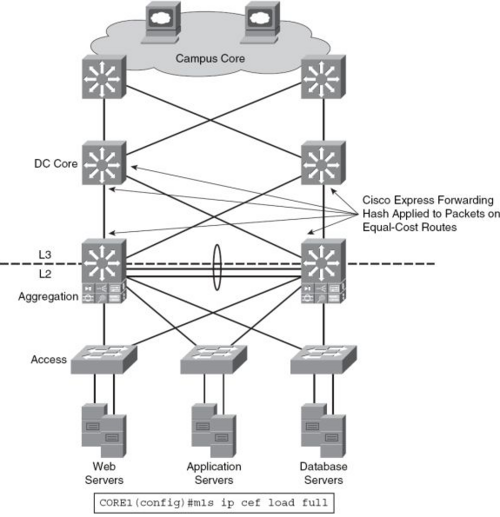Enterprise Data Center Design
Kapitel 5 fra CCDP ARCH bogen.
Contents
Cisco Catalyst 6500 serie switches Cisco Data Center Technologies
Designing The Core and Aggregation Layers
Data Center arkitekturen er baseret på en tre lags model.
- Core laget består af høj-hastigheds OSI lag 3.
- Aggregation laget forbinder Access-Laget med enten OSI lag 2 eller OSI lag 3.
- Access Laget giver fysisk forbindelse til Serverne.
fordele ved tre-lags modellen
- Hvis det er nødvendigt at samme VLAN skal være på flere Access Switche samtidig kan Aggregation-Switchene-----
Data Center Core layer design
Routnings Protokoller
OSPF
EIGRP
Aggregation Layer
Spanning tree design
Cisco anbefaler at benytte sig af RPVST+.
Aktiv STP,HSRP og Service Context Alignment
Active/Standby Service Module Design
I tegningen herunder er den ene Aggregation Switch Active og den anden Standby for al trafikken fra Access laget.
- Cisco 6500 med FSWM 2.x
Active/Active Service Module Design
I tegningen herunder er begge Aggregation Switche Active for hver deres VLAN's.
- Cisco 6500 med FSWM 3.1

|
Anvendelse af VRF (MPLS) i Data centeret
Access Lag
Lag 2 - Looped design
I Lag to Looped Design er VLAN's termineret i Aggregation laget og Lag 2 services som NIC teaming, Clustering og Statefull Services som for eksempel Firewall, Server Load Balancing, SSL kan udføres på ISO lag 2. Lag tre Routning foregår på Aggregations laget.
Lag 2 - Loop frit design
I Lag to Loop frit design er der ikke VLAN på Aggregationslaget modsat Looped design (Se overnfor). Ved omvendt U er det dog muligt at have VLAN på Aggregationslaget. Lag to services er supporteret. Lag tre Routning foregår på Aggregations laget.
Sammenligning af lag to Access designs
Lag 3 på Access laget
Statefull Services som kræver lag to konnektivitet kan ikke udføres af Aggregationslaget hvis Lag tre Routning foregår på Access-laget.
Multicast Source Support
6500 Services Module Placement Considerations
Active STP, HSRP, and Service Context Alignment
Establisheing Inbound Path Prefenrece
Route Health Injection(RHI) tillader at en Cisco CSM/ACE i en 6500 switch installerer en hoste route til den virtuelle server. /32 routen fjerner problemer med asymmetriske routing.
Designing the Access Layer
Layer 2 looped
VLANs are extended into the aggregation layer. Layer 2 services such as NIC teaming, clustering, and stateful services from the aggregation layer such as a firewall, SLB, and SSL can be provided across Layer 2 models. Layer 3 routing is first performed in the aggregation layer.
The Layer 2 looped triangle in Figure 5-14 has the following features:
- Supports VLAN extension/Layer 2 adjacency across the access layer.
- Resiliency is achieved with dual-homing and RSTP.
- Quick convergence with RSTP.
- Supports stateful services at the aggregation layer.
- Proven and widely used.
The Layer 2 looped square in Figure 5-14 has the following features:
- Supports VLAN extension/Layer 2 adjacency across the access layer.
- Resiliency is achieved with dual homing and STP.
- Quick convergence with 802.1w and 802.1s.
- Supports stateful services at the aggregation layer.
- Supports more access layer switches, optimizing 10 Gigabit Ethernet aggregation layer density.
- Active/active uplinks align well to active/active service module designs.
Layer 2 loop free
VLANs are not extended into the aggregation layer. Layer 2 services are supported. Layer 3 routing is first performed in the aggregation layer.
The following are characteristics of loop-free U access:
- VLANs are contained in switch pairs (no extension outside of switch pairs).
- No STP blocking; all uplinks are active.
- Layer 2 service modules black-hole traffic on uplink failure.
The following are characteristics of loop-free inverted U access:
- Supports VLAN extension.
- No STP blocking; all uplinks are active.
- Access switch uplink failure black-holes single attached servers.
- ISL scaling considerations.
- Supports all service module implementations.
Layer 3
Stateful services requiring Layer 2 connectivity cannot be provisioned from the aggregation layer. Layer 3 routing is first performed in the access layer.
 This article is under development....
This article is under development....






















